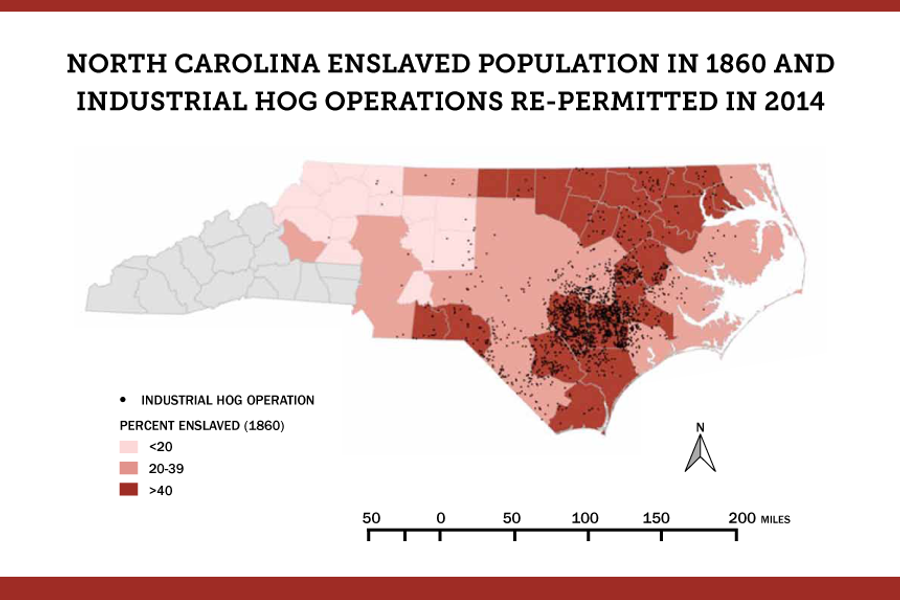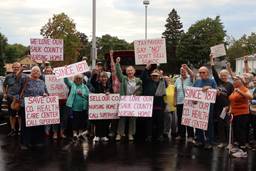The Legacy of Slavery: What Inequality and Industrial Hog Operations Have in Common
Laura Orlando

American agriculture is not one story, but many. Millions of animals living in confined spaces as part of large scale, market-directed production — industrial agribusiness — is one of the more horrific ones. For people that live near industrial hog operations, where hundreds or thousands of hogs are raised in a confined space, with open pits of urine and feces and regular disposal these wastes near their homes, it becomes a story about health and quality of life. Steve Wing, an epidemiologist at the University of North Carolina at Chapel Hill shows that it’s also about environmental injustice.
Research by Wing and Jill Johnston, a UNC postdoctoral scholar, documents that most of the 9.6 million hogs in North Carolina live in concentrated animal feeding operations (CAFOs) in the eastern part of the state where they disproportionately impact African Americans, Hispanics and Native Americans. Their 2014 study found that the swine CAFOs — also known as industrial hog operations (IHOs) — permitted by the North Carolina Division of Water Quality are located in counties with high non-white populations. Duplin County, on the southeastern coastal plain, is home to 2.35 million hogs distributed among 530 hog operations. In Duplin, 43 percent of the population is non-white. One of the poorest counties in North Carolina, Duplin has a poverty rate of 23.6 percent. Wing and Johnston do not focus directly on issues of wealth and poverty in their study, but they observe that IHOs are “relatively absent from low-poverty White communities.” After all, no industrial hog operation is located next to North Carolina’s Executive Mansion.
Over the past two decades, the number of U.S. hog farms declined by more than 70 percent while hog production rose by more than 30 percent, according to the U.S. Department of Agriculture. In 2007, 97 percent of hogs were raised in places with over 500 animals. Three-quarters of hogs sold for market are from “specialized operations” with corporate production contracts that buy 30 to 80 pound pigs from other “specialized operations” and finish them to 240 to 270 pounds, slaughter weight. The people that manage these operations are not called farmers: they are “contract growers.” Like other U.S. corporate agribusinesses, industrial hog operations are heavily supported by state and national policies. Larger operations are more profitable than smaller ones because the pigs are treated as commodities, their feed is mechanized, and the cost of environmental and public health damage is not considered in the balance sheet.
The human and environmental costs
Water and air pollution from the confinement of thousands of swine endanger the health of people living nearby. Industrial hog operations pollute the air with a complex mixture of particulates (e.g., fecal matter and endotoxins), vapors and gases (e.g., ammonia and hydrogen sulfide) — all of which have negative health effects. Add odor from feces, not only a nuisance but also the cause of health problems, and you get sick people. Wing and colleagues have recorded stress, anxiety, mucous membrane irritation, respiratory conditions, reduced lung function and acute blood pressure elevation.
North Carolina’s hog CAFO’s are concentrated in low-lying areas, where the hog-waste cesspools are susceptible to flooding. In addition, the runoff from liquid hog waste dumped or sprayed on fields makes its way into state waterways. Research from Johns Hopkins and UNC-Chapel Hill has found evidence of high concentrations of fecal indicator bacteria and the presence of swine-specific fecal MST markers in waters near hog CAFOs — meaning there are pig feces in the water.
Indeed, during the permitting process in North Carolina, IHOs are permitted as “non-discharge facilities,” which means they are exempt from state rules requiring the monitoring of their waste in waterways. The permit, in other words, essentially puts a “no regulation” stamp on a major source of water pollution.
It’s a public health crisis in these communities. Children do not play outside. Gardeners stop gardening. The stink, like nothing you have ever smelled before, is overpowering. Your body reacts to these real health problems. It’s response? Get me out of here. But when you live next to thousands of hogs and no one will buy your house, there’s no place to go.
At a lecture at Boston University in October 2014, Wing showed a dramatic slide that depicted a near perfect overlay of the location of industrial hog farms to the density of slave populations in the 1860s. The concentration of millions of pigs in southeastern North Carolina is made possible by racial injustices that deny people basic rights. Wing writes, “If workers and residents in rural communities that are most directly impacted had basic political and human rights, industrial agriculture would not have developed with such destructive force because those affected by its side effects would have been able to protect themselves.”
Industrial animal waste cesspools
It’s hard to know what to do when there’s a hostile corporate neighbor with thousands of hogs living next door. Local, state and federal governments are no help. But a number of organizations — North Carolina Environmental Justice Network, Earthjustice, Concerned Citizens of Tillery, Rural Empowerment Association for Community Help, and Waterkeeper Alliance — are fighting the good fight.
The Concerned Citizens of Tillery (CCT), an environmental justice organization established in 1978 and located in Tillery, a community in eastern NC has been organizing the opposition to IHOs for decades. The experience of the homestead farm isn’t as common as it used to be, where a few pigs are part of the farm ecosystem and hundreds (or thousands!) would be known to wreck it. Like an invasive weed, it takes patience and effort to convince people the weed wasn’t always there.
When CCT is asked why hogs and dangerous pollutants come into poor, rural communities, the group responds, “Because there are Blacks and Latinos and Native Americans living in these communities.” The organization’s website puts it this way: “We have become a society based on consumption and materialism, the inevitable environmental degradation begins in the ‘backyards’ of African Americans, other people of color and yes, poor whites who could not ‘flight’ to urban America.”
I met Gary Grant, the long-time executive director of CCT, several years ago. By the time I met him, I’d been inside buildings with thousands of hogs. I’d walked around the cesspools the industry likes to call “lagoons.” It’s hard not to see the horror of the animals’ lives and the ruination on the lives of the people living nearby.
Steve Wing and his colleagues illustrate how North Carolina industrial hog operations degrade the environment and health of people living near them. They have documented that the facilities built to house hundreds or thousands of hogs and the resulting cesspools and waste disposal fields are mostly located near the homes of people of color. Gary Grant knows this. It’s about time a whole lot of other people learned about it. Wing reminds us that making sustainability and decency an integral part of the food system can improve life for everybody. Now that’s a story to be part of.








